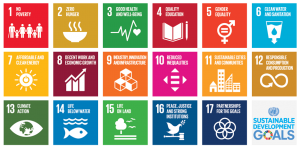Rebecca De Cicco, global chair for Women in BIM and principal, digital enablement at Aurecon explains the importance of the United Nations Sustainable Development Goals for gender equality and BIM
Sustainable development and climate action are intrinsically linked. Both are vital to the present and future wellbeing of society and for Women in BIM (WIB), they represent a core feature of our work for our members worldwide.
At WIB, we are committed to ensuring our members and supporters are kept informed on critical areas of interest which affect our work and the incentives and projects we focus on. Like many other organisations and member bodies, sustainability is at the heart of our operations.
United Nations Sustainable Development Goals
One of our key drivers as a community is the link to the United Nations Sustainable Development Goals (SDGs). These goals have been developed by all United Nations member states to share a vision for peace and prosperity for people and for our planet.

It is essential we continue to drive the efforts around these goals for their potential implementation (as noted in their guidance) by 2030. As we look ahead to 2030, what we currently see is not a fully diverse industry, but one with the opportunity for significant change. Change that could fundamentally alter and support how we live and work all over the world.
The UN’s SDGs show us that greater emphasis needs to be placed on the wellbeing of people and our nations across the globe. The goals comprise of 17 key areas, which are essentially a call to action by all countries in global partnership and, to me, this signifies a focus on collaboration and community in our evolving world. Something which is quite a challenging feat given the current social and economic impacts affecting all of our regions.
Although there is a need to focus on each of the goals, our primary interest relating to WIB is around gender equality in BIM, with the aim of promoting and encouraging more women in our industry to support change.
UN cites gender equality as a fundamental human right
If we look at Goal 5: Gender Equality, the UN cites gender equality as not only a fundamental human right, but a necessary foundation for a peaceful, prosperous and sustainable world.
Construction is challenged with cultural issues which are forcing too many women out of the industry, and we hope that with the evolution of digital roles in construction, more women will find this a more appealing career of choice.
The goal around gender equality is broader obviously than women in construction, however they relate to what we do and how we endorse their relevance, because without something like this, when promoting and acknowledging the importance of diversity and equality we run the risk of being underrepresented.
We are now entering the third year of the Covid-19 pandemic and the subsequent effects on people’s lives and livelihoods is paramount. On a global view, the efforts to realise the SDGs is challenging and we have not as yet seen as much of a positive impact as we would have liked.
Despite continued data gaps at national levels, the present reporting shared in 2022 shows that years, or even decades, of development progress have been halted or reversed as a result of the pandemic, which is alarming and somewhat upsetting in so far as how far we have progressed as a global community.
Drive women to retain their roles in our industry
However, having said this, there has been a rapid uptake of wider pools of support around flexible and remote working, all of which help to drive women to retain their roles in our industry, yet very little data to back up these claims. As of 2021, more than 5.4m people worldwide had died directly due to Covid-19 and with this came unprecedented impact on our health systems, way of working and focus on the sustainability goals. As we look to the reporting provided by the UN in relation to tracking the SDGs, the world is not on track to achieve gender equality by 2030 and has been pushed further off track by the socioeconomic fallout of the pandemic.
Women and girls remain disproportionately affected, struggling with lost jobs and livelihoods, derailed education, increased burdens of unpaid care work and domestic violence. Over 100m women aged 25-54, with small children at home, were out of the workforce globally in 2020, including the more than 2m who left the labour force due to the increased pressures of unpaid care work.
Women accounted for 39.4% of total employment
Women accounted for 39.4% of total employment before the pandemic in 2019 but made up nearly 45% of global employment losses in 2020. The share of women in managerial positions worldwide has shown only a slight improvement over the last two decades, rising from 25.3% in 2000 to 28.3% in 2019, and remained unchanged in 2020.
Sadly, many countries do not have comprehensive systems to track budgets for gender equality, limiting the allocation of public resources for implementation of laws and policies. Efforts must be made to strengthen laws, policies, budgets and institutions in the advancement of gender equality. Now is the time to unite and strive towards this as an industry.
How can the UN goals support gender equality in BIM?
If we look to the future, we need to make a positive impact on how the UN goals can support gender equality in BIM in a way which is not only recommended but enforced, tracked and measured as policy across our jurisdictions. Without an adequate form of measuring the impact of women in construction, and digital roles generally, we cannot begin to try to change the lower representation and in fact the issues women still face on a global level when it comes to equality.
The SDGs are all achievable in some way and as an industry we need to find our way to deliver them.

Rebecca De Cicco
Global chair













![[VIDEO] Local planning inspector recruitment to begin in earnest in new year A drive to recruit local planning inspectors will begin in the new year](https://www.pbctoday.co.uk/news/wp-content/uploads/2025/12/iStock-2159482095-2-218x150.jpg)
